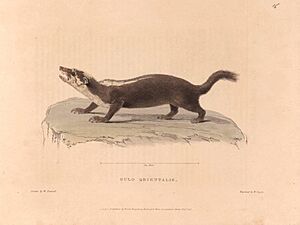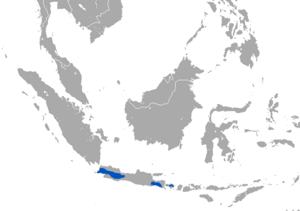Javan ferret-badger facts for kids
Quick facts for kids Javan ferret-badger |
|
|---|---|
 |
|
| Conservation status | |
| Scientific classification | |
| Genus: |
Melogale
|
| Species: |
orientalis
|
 |
|
| Javan ferret-badger range | |
| Synonyms | |
|
Melogale personata ssp. orientalis Blanford, 1888 |
|
The Javan ferret-badger (Melogale orientalis) is a small, furry animal that belongs to the weasel family. It lives only on the islands of Java and Bali in Indonesia. This badger is found in or near forests, from about 260 to 2,230 meters (850 to 7,300 feet) above sea level. Scientists currently list it as a species of Least Concern, meaning it is not in immediate danger of disappearing.
Contents
What Does a Javan Ferret-Badger Look Like?
An adult Javan ferret-badger usually weighs between 1 and 2 kilograms (2.2 to 4.4 pounds). Its body is about 35 to 40 centimeters (14 to 16 inches) long. The tail adds another 14.5 to 17 centimeters (5.7 to 6.7 inches) to its length.
Physical Features
This badger has a small head with a narrow, rounded snout. It has long whiskers and large eyes. Its body is low to the ground, covered in soft, silky brown fur. Sometimes, the fur can look reddish, yellowish-brown, or grayish. The back of its head and throat are darker brown. It also has white markings on its face, neck, throat, chest, and belly.
Where Do Javan Ferret-Badgers Live?
The Javan ferret-badger is found only on the islands of Java and Bali in Indonesia. We don't know its exact range, but it lives in hilly and mountainous areas. It might also be found in lower places.
Known Locations
In western Java, these badgers have been seen in Mount Halimun Salak National Park. They also live in Gunung Gede Pangrango National Park. On Bali, one was seen in a primary forest (an old, untouched forest) at 1,180 meters (3,870 feet) high. Others were found near human homes in secondary forest (forest that has regrown) and rubber plantations. Javan ferret-badgers have been recorded in about 30 different places across Java and Bali.
How Do Javan Ferret-Badgers Behave?
Like other ferret-badgers, the Javan ferret-badger is a fossorial animal. This means it spends time digging and living underground. It often uses burrows that other animals have already made in the forest floor.
Daily Life and Diet
These badgers are mostly nocturnal, meaning they are active at night. Small groups of adults and young badgers often search for food together. They are usually found in thick bushes and might even climb trees. Their diet is mainly carnivorous, which means they eat meat. They hunt small animals, birds, amphibians, and invertebrates (like insects). They also eat eggs, dead animals (carrion), and some fruit.
Reproduction
Based on young badgers offered for sale online, it seems they have their babies mostly between December and March.
Interactions with Humans
In Gunung Gede Pangrango National Park, Javan ferret-badgers seem quite common. They have been seen looking for food scraps in picnic areas after dark. They also turn over leaf litter (fallen leaves) to find food. These badgers don't seem bothered by people. One young badger even ate biscuits from a person's hand!
Threats and Conservation Efforts
Much of Java's original forest has been broken up and damaged. However, the Javan ferret-badger seems able to adjust to these changes. They have been found living in regrown forests and plantations.
Illegal Wildlife Trade
From 2011 to 2020, Javan ferret-badgers were seen for sale in eleven wildlife markets on Java and Bali. They were also sold on several online websites. This trade can be a threat to their populations.


